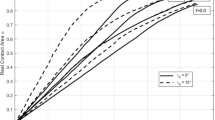Abstract
Microforming is a very attractive and suitable manufacturing technology for the production of microscale parts since it enables to utilize a wide range of materials with high production rates and minimized material loss. Previous researches on microforming have shown that the traditional friction model can lead to significantly erroneous results. Thus, for successful development and applications of microforming process, a critical consideration of the tribological size effect is required. This paper investigates the tribological size effect in microforming of pure copper by scaled upsetting experiments of disks. In order to explain the mechanism of the friction size effect, a simple theoretical analysis was performed based on the upper-bound theorem and the lubricant pocket model. The sensitivity of the friction to the deformation characteristics of the material was analyzed using finite element analysis (FEA) under a wide range of friction conditions. In addition, upsetting tests of disks enabled to verify the effectiveness of the theoretical and FEA models and explained the change of the frictional behavior with the reduction of the part size qualitatively and quantitatively.
Similar content being viewed by others
References
Engel U, Egerer E (2002) Basic research on cold and warm forging of microparts. Key Eng Mat 233–236:449–455
Tiesler N, Engel U (2000) Microforming-effects of miniaturization. Proc. 8th International Conference on Metal Forming, p. 355–360
Nam JS, Lee SW, Kim HS (2014) Investigations into the size effect on plastic deformation behavior of metallic materials in microcoining process. Int J Precis Eng Manuf 15:5–11
Schey (1983) Tribology in metalworking: friction, lubrication, and wear. American Society for Metals, Metals Park
Wanheim T (1973) Friction at high normal pressures. Wear 25:225–244
Geiger M, Kleiner M, Eckstein R, Tiesler N, Engel U (2001) Microforming. CIRP Ann 50:445–462
Buschhausen A, Weinmann K, Lee JY, Altan T (1992) Evaluation of lubrication and friction in cold forging using a double backward extrusion process. J Mater Process Tech 33:95–108
Tiesler N (2002) Microforming—size effects in friction and their influence on extrusion process. Wire 52:34–38
Tiesler N, Engel U, Geiger M (1999) Forming of microparts—effects of miniaturization on friction. Proc. 6th ICTP 2: 889–894
Male AT, Cockroft MG (1965) A method for the determination of the coefficients of friction of metal under bulk plastic deformation. J Inst Met 93:38–46
Engel U, Messner A, Tiesler N (1998) Cold forging of microparts—effect of miniaturization on friction. Proc. 1st ESAFORM Conference on Materials Forming, p. 77–80
Vollertsen F, Hu Z (2006) Tribological size effects in sheet metal forming measured by a strip drawing test. CIRP Ann 55:291–294
Engel U (2006) Tribology in microforming. Wear 260:265–273
Jeon HJ, Bramley AN (2007) A friction model for microforming. Int J Adv Manuf Tech 33:125–129
Malayappan S, Narayanasamy R (2004) Some aspects on barrelling in aluminium solid cylinders during cold upset forging using a die with constraints. Int J Adv Manuf Tech 23:636–643
Schey JA, Venner TR, Takomana SL (1982) Shape changes in the upsetting of slender cylinders. J Eng Ind 104:79–83
Wu MC, Yeh WC (2007) Effect of natural boundary conditions on the upper-bound analysis of upset forging of ring and disks. Mater Des 28:1245–1256
Alexandrov S (2000) An analysis of the axisymmetric compression of viscous materials. J Mater Process Tech 105:278–283
Kim HS (2010) A combined FEA and design of experiments approach for the design and analysis of warm forming of aluminum sheet alloys. Int J Adv Manuf Tech 51:1–14
Kim HS, Lee YS (2012) Size dependence of flow stress and plastic behaviour in microforming of polycrystalline metallic materials. Proc Inst Mech Eng C J Mech Eng Sci 226:403–412
Leu DK (2009) Modeling of size effect on tensile flow stress of sheet metal in microforming. J Manuf Sci E T ASME 131:011002.1–011002.8
Nam JS, Park IG, Lee SW, Kim HS (2012) Development of a miniaturized microforming system and investigation of deformation behavior of material for the production of micro components by forming. J Korean Soc Precis Eng 29:1221–1227
Ghassemali E, Tan M, Jarfors AEW, Lim SCV (2013) Progressive microforming process: towards the mass production of micro-parts using sheet metal. Int J Adv Manuf Tech 66:611–621
Author information
Authors and Affiliations
Corresponding author
Rights and permissions
About this article
Cite this article
Kim, H.S. Determination of the tribological size effects in microforming through the scaled upsetting tests of disks. Int J Adv Manuf Technol 75, 1253–1261 (2014). https://doi.org/10.1007/s00170-014-6149-0
Received:
Accepted:
Published:
Issue Date:
DOI: https://doi.org/10.1007/s00170-014-6149-0




